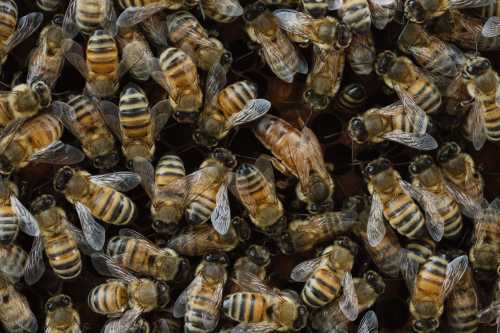Which Bee Is The Most Important In A Hive?
Whilst it is true that all individual bees within a honey bee colony perform a vital role, there is only one queen, and her removal in the short term would have a greater (if temporary) impact on the behaviour of the colony.
Which Bee Is The Most Important In A Hive?
 Honey bee colony - can you spot the queen?
Honey bee colony - can you spot the queen?
In one sense, I confess to feeling a little uncomfortable with this question. I would not wish to imply that all members of a honey bee colony except the queen, are easily dispensable and don't really matter.
At the end of the day, whilst there is only one queen in a typical hive or nest, a honey bee colony is a superorganism. Workers and drones play a vital role, and without them, the queen cannot be born and cannot thrive.
However, it is true that if the honey bee queen is removed, it will temporarily have a more significant impact on the colony than if a single drone or worker were taken away or died.
Indeed, the life cycles of drones and workers is short in comparison with that of the queen, who may live several years. Loss of drones and workers happens on a regular basis. However, to state that they are less important is perhaps misleading. Workers and drones are crucial, but their individual roles are more immediately covered by other colony members in the event of loss of an individual.
Nevertheless, it's perhaps worth outlining a few of the key points of debate nestled within this question.

Why the queen is important in the honey bee colony
The key role of the queen is to lay eggs that will ensure future generations and colonies of honey bees.
Whilst workers can lay eggs (and indeed, sometimes they will engage in egg-laying) all eggs laid by workers will be drones (males).
Only the queen will mate with drones, and produce females from fertilized eggs. You can read more about this on my page: Do bees have X and Y chromosomes.
The queen also keeps the colony functioning efficiently, by regulating the behaviour of workers through communication via pheromones.
In addition, a queen is necessary for the formation of a new colony which occurs following the act of swarming.
If the queen were to be removed or die suddenly, this could temporarily interfere with egg laying, and hence the rearing of workers, and hamper productivity of the colony.
However, in the event of such an incident, the workers would set about rearing a new queen.
 A swarm of honey bees - swarms begin the formation of new honey bee colonies
A swarm of honey bees - swarms begin the formation of new honey bee coloniesWhy workers are important in the honey bee colony
A honey bee colony has thousands of workers. Whilst they themselves cannot exist without the queen (she laid the egg from which the worker developed), the queen cannot exist without her workers.
Worker honey bees not only feed her (and the rest of the colony) and rear the larvae (the queen's offspring) they effectively rear new, replacement queens too! All larvae are fed royal jelly1 for 3 days, which is a substance secreted from glands in the heads (hypopharyngeal glands) of very young worker bees (nurse bees). However, larvae destined to become queens continue to receive royal jelly after the 3 days. Again, this royal jelly is made by honey bee workers.
Thus, a queen cannot exist without her workers. The queen was herself reared by workers, and is fed by them. The workers also build the wax cells in which the queen lays her eggs, and that includes the cell in which the queen was raised.
However, given that there are thousands of workers, the sudden removal or death of a single worker would have no significant impact on the honey bee colony, since a fellow worker would step in to perform the role.
Indeed, the roles of workers change as the bee ages.
Older workers go out to forage for the colony (collecting nectar and pollen as well as water) whilst younger members remain at the nest or hive.
The death of a critical number of workers, would however, result in the death of a colony, including the queen and drones.
A queen will require workers to create a swarm, seek out a suitable nest site, and help her establish a new colony.
 Worker honey bees forage not only for nectar and pollen, but also collect water to take back to the nest of hive
Worker honey bees forage not only for nectar and pollen, but also collect water to take back to the nest of hiveWhy drones are important in the honey bee colony
The life of a drone may be short, but without the drone, there can be no workers, and indeed, no queen.
For the drone, the act of mating with the queen is a suicidal one, which nevertheless ensures the continuation of the species.
As with the workers, the loss of a single drone may be insignificant to a colony, as long as other drones are available to mate with the queen, but a loss of all healthy drones would mean a loss of fertilized eggs that produce new queens and workers.
References
1. Kucharski R, Maleszka J, Foret S, Maleszka R. Nutritional control of reproductive status in honeybees via DNA methylation. Science. 2008 Mar 28;319(5871):1827-30. doi: 10.1126/science.1153069. Epub 2008 Mar 13. PMID: 18339900.
- See links within text to other pages on this website.



